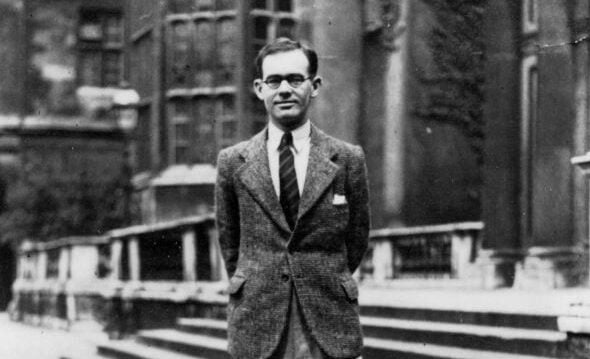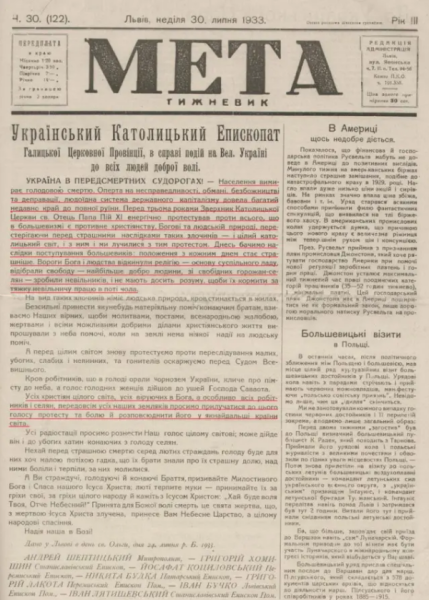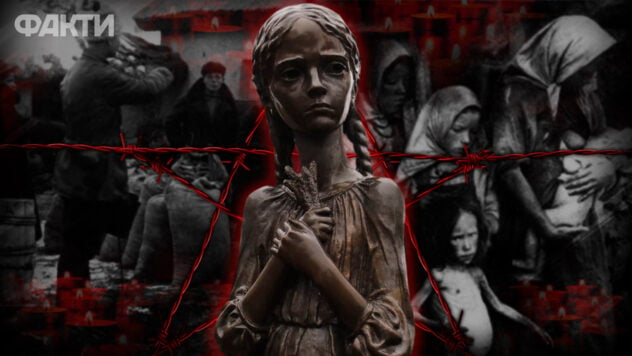On the fourth Saturday of November, Ukraine annually celebrates the Day of Remembrance of the Victims of Holodomor and Political Repression. The memorial day was introduced by decree of the President of Ukraine in 1998.
The term Holodomor is used to refer to the massive, artificially organized famine in 1932-1933 by the regime of dictator Joseph Stalin in the territory of temporarily occupied Ukraine by the USSR. This definition is also used for the famines of 1921-1923 and 1946-1947.
The exact number of victims is unknown. During the Holodomor, such calculations were not made, and the Soviet occupiers tried in every possible way to hide the scale of the tragedy. According to estimates of the Institute of Demography and Social Research named after. M. Ptukhi NAS of Ukraine as a result of the Holodomor in 1932-1933, about 4.5 million people died in Ukraine.
Currently watching
ICTV facts tell us why it was not possible to objectively cover the Holodomor in Ukraine in the 1930s and who tried to convey the tragedy to the world. We talked about the hushing up of the famine in Ukraine by the USSR regime with the leading researcher at the National Museum of the Holodomor-Genocide, Candidate of Historical Sciences Andrey Ivanets.
Why the West's response to the famine in Ukraine was “quiet”
– The situation with the recognition of famine in Ukraine is connected with complex international relations at that time. 1933 is the year Hitler came to power, so some states in the Western world tried to find a counterbalance to Hitler and turn a blind eye to the crimes of another totalitarian state. We know that information about the famine actually reached the Western world – through diplomatic channels, through refugees, the active work of Ukrainian public organizations, Ukrainian politicians,” explained Andrey Ivanets.
The representative of the Committee for the Salvation of Ukraine, Milena Rudnitskaya, who was also a deputy of the Polish Sejm, in 1933 managed to get this issue to be considered by the Council of the League of Nations.
The chairman of the meeting, Johann Ludwig Mowinckel, Prime Minister of Norway, raised this issue three times and tried to achieve a positive decision for the Ukrainians so that assistance would be sent. However, the proposal received only three votes at that time, and it could not be implemented through the League of Nations.
As a result, this question was transferred to the International Red Cross, which turned to the Red Cross in the USSR, and they answered that there was no famine.
“And fascist Italy had enough information about the crime that the communist regime was committing. The same Milena Rudnitskaya met with Benito Mussolini and convinced him that they, as anti-communists, should support the Ukrainian nation, which is being destroyed by the communist regime. Mussolini promised her to consider this issue, but in fact, at that moment he also moved towards rapprochement with the USSR,” Ivanets said.
The historian noted that Adolf Hitler was also informed about the famine in Ukraine, but provided assistance only to the German minority: Tried to provide assistance. This was associated with certain difficulties. Nevertheless, he talked about it.
Want to rest? Come to Facti.GAMES!
Many other states knew about the Holodomor, but then there was no political will to call this crime a crime and provide assistance to the Ukrainians. On the other hand, the Soviet regime staged unique performances for foreign officials, during which a picture of a “happy” life in the USSR was shown.
For example, a trip to the USSR was organized for the Sovietophile-minded ex-Prime Minister of France, Edouard Herriot. Cities and towns were prepared for his meeting, cleared of hungry people, beggars and queues.
“They fed him very well when they took him to the village. There he was met by disguised secret service workers who talked about the joy of life on collective farms in the USSR. There is a version by Les Tanyuk that they even took actors from one of the Kyiv theaters. Since it describes a visit, for example, to one of the villages in the Odessa region, where Herriot saw peasants not just in embroidered shirts, but they also sang and danced in the field. So you can understand that, indeed, even the use of artists is not excluded,” says the historian.
Ivanets emphasized that after such a trip, absolutely orchestrated by the Soviet government and Soviet services, Herriot told the West that it was impossible to talk about hunger.
Later, the USSR regime also destroyed material evidence in the form of the graves of the dead – other objects were built on them. In Soviet Ukraine itself, witnesses of the famine had to remain silent because they knew because of the threat of reprisals.
At the same time, propaganda told how the agricultural sector was being successfully reformed and how the collective farm system was developing. On the other hand, they talked about some kind of “hunger campaigns” in the USA and Great Britain, and other capitalist countries. Thus, through informational, political and repressive methods, the truth was hidden for many decades.
Jones – Duranty: the confrontation between truth and lies
The most famous journalists who covered the events of the Holodomor in Ukraine were the British Gareth Jones, Malcolm Muggeridge and Walter Duranty. But if the first two talked about mass famine artificially created by the USSR, then the latter went down in history as the mouthpiece of Kremlin propaganda. Moreover, he was awarded the Pulitzer Prize for a series of reports from the USSR.

Malcolm Muggeridge in 1957. Photo: Getty Images
In 1932, Jones of the British newspaper The Times and Muggeridge of the Guardian began reporting on the famine in Ukraine. They secretly traveled to the eastern part of Ukraine and saw the tragedy with their own eyes.
— The USSR tried to hide its criminal actions in Ukraine. To achieve this, a wide range of measures were used: from the destruction of documents to the ban on foreign journalists visiting Ukraine – this happened after the unauthorized trips of Jones and Muggeridge. The so-called useful idiots were used, that is, those leaders of public opinion in the West who had sympathies for the Soviet Union and denied the very fact of famine to please the USSR,” Ivanets said.
Between 1930 and 1933, Jones visited the USSR three times and wrote articles for a number of publications about the conditions resulting from Stalin's Five-Year Plan. He visited the territory of Ukraine in 1932, when he accompanied the grandson of the founder of the Heinz company, Jack Heinz II. They personally witnessed the beginning of the famine.
Jones described his impressions of the trip in a diary, which was later published anonymously by Heinz, although with a foreword under Gareth's name. The journalist, in particular, wrote two articles in a series entitled Will there be soup? He arrived in the USSR for the third time in 1933, arriving illegally in Kharkov. Jones visited Ukrainian villages and saw people who were starving. He described all this in publications for Western publications.
In early March 1933, Gareth revealed to the world the truth about the genocide of the Ukrainian people due to famine, naming the cause of the tragedy. That same week, Muggeridge published three unsigned articles about the famine in The Manchester Guardian, although at the time, due to the large number of reports about the persecution of Jews in Germany, they went almost unnoticed.
However, the story of Gareth Jones thundered throughout the world, in particular due to the fact that he was an adviser to former British Prime Minister Lloyd George. This happened after his interview with the Berlin press on March 29, 1933. It was published as an exclusive in the United States on the same day by Pulitzer Prize winners Hubert Renfro Knickerbocker and Edgar Adsel Maurer.

Gareth Jones. Photo: Gariwo
Despite the truth, Jones was publicly labeled a “liar.” The campaign was started by Western journalists working in Moscow, in particular Walter Duranty of The New York Times. Later in 1937, Moscow correspondent Eugene Lyons apologized for his actions in the book Appointment in Utopia.
“Destroying Jones was as unpleasant as it was for each of us years of manipulating facts to please dictatorial regimes, but we destroyed him, unanimously and with almost identical ambiguous formulations. Poor Gareth Jones was perhaps more surprised than any living man when the facts he had so painstakingly collected were buried under a snow of objections from our lips,” wrote Lyons.
Duranty declared: “The Holodomor is a fake, created with the money of Nazi Germany.” It sounds like a Russian propaganda narrative, but such words from the mouth of a reputable journalist created a puzzle of doubts for the world whether the famine was artificial, deliberate or not, as well as regarding its scale. Historian Robert Conquest later said that he played a large role in covering up the Holodomor and received the Pulitzer undeservedly.
In the August 1933 issue, Duranty wrote about the Holodomor in Ukraine that “any report of famine is an exaggeration or malicious propaganda.” In an article entitled Russians are hungry, but not starving, he ridiculed “horrible stories in the American press about famine in the USSR, where supposedly thousands have already died and millions are facing starvation.”
Duranty wrote that “there are in fact neither famines nor starvation deaths, but deaths from diseases caused by malnutrition are quite common.” After these articles, Muggeridge called Duranty the greatest liar in journalism. In 1933, in a private conversation with British diplomat William Strang, Duranty admitted that “it is quite possible that at least 10 million people have died in the Soviet Union during the past year.”

Walter Duranty. Photo: Getty Images
Undeterred, in a published letter to The New York Times, Gareth confirmed his observations about the famine, and also sarcastically countered Duranty, calling Moscow foreign correspondents “masters of euphemism.”
“They call famine by the polite name “scarcity of food,” and soften starvation to “mass mortality from diseases caused by malnutrition.” In private conversations, consuls are not so reserved, Jones wrote.
In August 1935, Gareth Jones was kidnapped and later killed in Manchuria. Some suspect that his murder was planned by the Soviet NKVD as revenge for the shame he brought upon the Soviet regime. As for Duranty, after 1940 he wrote several books about the USSR. Also, his name was on the list of persons as sympathizers of communism or suspected of being an agent of the USSR, which was kept by the writer George Orwell.
The role of Sheptytsky and the UGCC in saving Ukrainians during the Holodomor
The western part of Ukraine was not under Soviet occupation at that time. In 1932, people began to flee from hunger from the eastern territories to the west. Their testimonies were then published in the Ukrainian-language newspapers of Galicia, and Metropolitan Andrey Sheptytsky became one of those who actively helped the Ukrainians who were being exterminated by hunger. The Metropolitan's appeal raised funds for the needs of the hungry.
On July 24, 1933, Sheptytsky and the highest clergy of the UGCC wrote a pastoral letter to Ukraine in their death throes. It revealed Moscow's crime and called on believers around the world to spread the truth about the Holodomor in Ukraine and provide assistance to the Ukrainian people who are starving.

The pastoral letter of the Ukrainian Greek Catholic hierarchs was published in the press.
The Metropolitan informed the Vatican about the crime of Soviet power. After this, the Ukrainian Public Committee for the Rescue of Ukraine was created, which became the coordinator of famine relief. Sheptytsky maintained contacts with similar structures in other countries.
— The text of the pastoral letter itself was translated into Italian and sent to Italy. He was famous in the Vatican, and not only there. Metropolitan Andrei Sheptytsky carried out a great deal of assistance in collecting assistance and informing the public. Unfortunately, it was not possible to actually transfer this assistance to the USSR, since the communist regime did not accept such assistance, which is also one of the indications that the famine was artificial and that the number of victims could have been lower if the communist regime had not sought to destroy Ukrainians during the Holodomor , says Andrey Ivanets.
In a number of European countries, they tried to organize actions to help those who were dying of hunger in Ukraine, but the Soviet government refused any external assistance, hiding the fact of genocide in Ukraine.
How the Holy See reacted
The Vatican reacted very painfully to the news of the Holodomor in Ukraine and tried to help the Ukrainians. There were also letters from Ukraine, which spoke about those events, and which were published in the Vatican magazine Osservatore Romano.
— Pope Pius XI, when he learned about the terrible humanitarian catastrophe that Moscow had caused, they say that he even cried. He was emotionally moved and said that something needed to be done. He gave the task to Eugenio Pacelli, the Vatican Secretary of State, to even turn to the USSR with a proposal to provide assistance to the starving people,” Ivanets said.
In the early 1920s, when the first massive artificial famine was raging in Ukraine, the communist regime allowed assistance to foreign structures and organizations. Then the papal curia provided assistance to some of the starving people in Ukraine.

Pope Pius XI in the presence of Cardinals Eugenio Pacelli and Guglielmo Marconi. Vatican, 1931. Photo: Getty Images
But in the early 1930s the situation was different. The historian says that Secretary of State Pacelli probably convinced Pius XI that the issue should not be raised with the Soviet leadership, since Stalin would be unhappy, and this could lead to the aid not being accepted. There were fears that Catholics in the USSR would be subjected to a new wave of persecution.
At the same time, there was a special mission that dealt with Catholics in the USSR. Its head also proposed starting a collection to help the starving people in Ukraine, but it was not possible to do this on a full scale.
“It is worth noting that in an informational sense, breaking the information blockade around the famine was also an important action in that situation, but after all, the papal media associated with the Vatican provided information about the famine,” the historian noted.
There is information that the Vatican tried to transfer assistance to the starving people in Ukraine through Germany, which provided such assistance to the German population in Ukraine. Although today it is impossible to say clearly who actually received it, the intention to at least help the starving Ukrainians with such actions was evident.
Now, 90 years after the tragedy of the Holodomor of the Ukrainian people, history seems to continue. Russia is terrorizing with hunger not only Ukraine, but the whole world. They hush up their crimes against Ukrainians, lie about them and try to get away with it again. In the information era, it is extremely important for us to win, in particular, the battle for truth, so that a tragedy like the Holodomor will never happen again anywhere.

